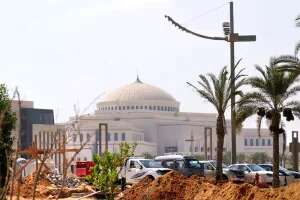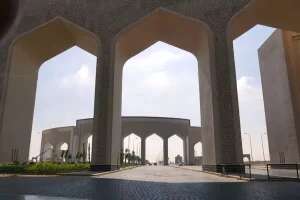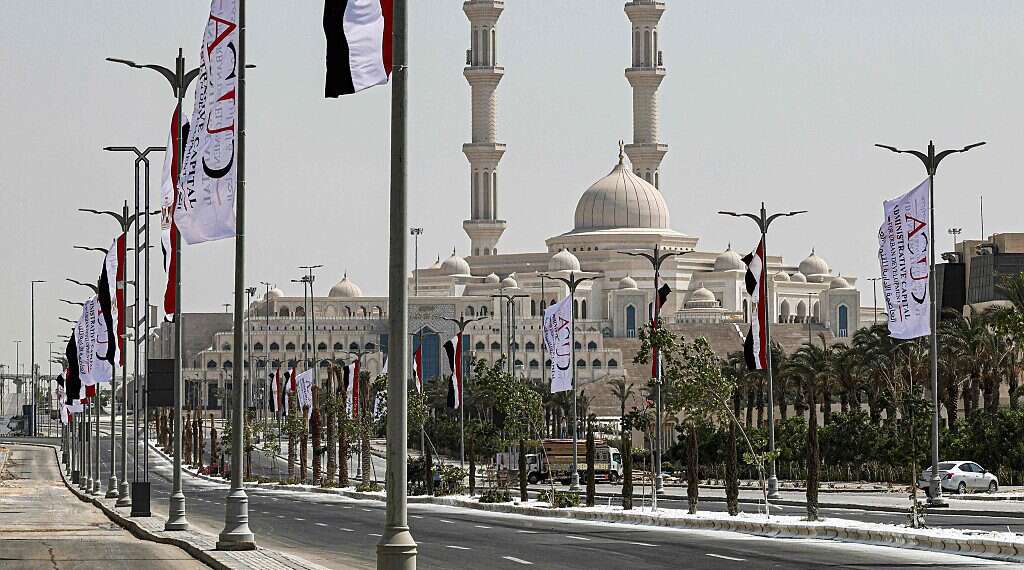It was hard to imagine Egypt having a new capital. I love Cairo – for its built-in chaos, bustling streets, and markets, constant hustle and traffic, the vast Nile River, its mosques, restaurants, clubs, palaces, and slums, as well as its cinemas, newsstands, and books. I did not think Cairo could be replaced.
Follow Israel Hayom on Facebook, Twitter, and Instagram
I first visited the city in 1986 as an Arab affairs correspondent for Army Radio, almost a decade after the historic visit by Egyptian President Anwar Sadat to Jerusalem. Cairo was very different back then: neglected, dirty, congested, and outdated. Even luxury hotels had poor service and infrastructure. Phone lines barely worked and every call had an unbearable noise in the background before being cut off. And driving anywhere took hours due to the congestion.
Since then, I have visited Cairo many times: during negotiations for the Oslo Accords, the Egyptian revolution that resulted in the overthrow of Hosni Mubarak, the rise of the Muslim Brotherhood, and the protests that led to the ouster of Mohamed Morsi.
Each time I saw Egypt improve: new bridges made traffic faster and the building of green spaces tackled the population density.
In recent years I have also witnessed the beginning of the restoration of historic Cairo. The countless beggars who made every visit to the city's important sites a nightmare were banished. Under President Abdel-Fattah el-Sissi's rule, Cairo became safer. He was the one who ordered the horrific slums in the heart of the city to be cleared, and in their place business and residential towers were built.
El-Sissi also tackled the over two million illegal and ugly red brick residential buildings that had sprung up not only in the capital but throughout all of Egypt, particularly during the Arab Spring.
Dozens of them have collapsed in recent years, killing the residents, which is why Egypt is desperate for a housing alternative. Add to that the country's relentless population growth – a yearly increase of two million people adding to the current 113 million Egyptians living in the country. Egypt is the most populous country in the Middle East, and 14th most populous in the world.
The government's efforts to implement "family planning" – a.k.a. to decrease the birth rate – have failed so far.
Officially, the New Administrative Capital is supposed to help solve the housing crisis. It is, by the way, only one of 15 new cities that Egypt plans to build – several of which are in the advanced stages of implementation – to significantly expand the uninhabited areas in the country, such as the initiative taken in various areas of the Sinai Peninsula after it was restored to Egyptian sovereignty in 1982.

Only about 10% of Egyptian territory is inhabited and used today – in the Nile Valley, in the Delta, and along the Suez Canal and the Red Sea. As part of Egypt's Vision 2030, a program similar to Saudi Arabia's, the government seeks to make the wasteland bloom using advanced technologies.
Only Cairo does not have the money Riyadh does, and as such must rely on others. However, one of the successes of the vision is New Alamein built near the scene of the turning point of the North African campaign in World War II.
The construction of New Alamein began in 2018, at the same time as the construction of the yet-to-be-named New Administrative Capital. Located on the shores of the Mediterranean Sea, about 250 kilometers (155 miles) northwest of Cairo, New Alamein is intended to become a massive tourist city, one that will reduce pressure on Alexandria, the summer city located about 100 kilometers (62 miles) away.
And New Alamein is a tourist city indeed: its hotels built along the pristine seashores hosted thousands of tourists this summer – locals and foreigners, mainly from around the Arab world, who traveled to the New Alamein Festival, considered the largest entertainment event in the Middle East, with the participation of the best artists of the Arab world. Egyptian authorities estimated that around a million people attended the festival.
In addition to the entertainment events, el-Sisi put the New Alamein on the political map, when he held a series of important political meetings in his new palace in the city, with the leaders of the United Arab Emirates, Bahrain, and Palestinian Authority, as well as a tripartite summit with King Abdullah of Jordan and PA President Mahmoud Abbas.
The palace serves as one of el-Sissi's summer palaces, and the high cost of its construction was and still is subject to public criticism. And yet, the new capital is the "flagship" of the Egyptian president's ambitious development plans.
A capital without a name
Ancient Egyptians called their homeland Kemet, meaning "black land," referring to the dark, fertile soil left behind after flooding from the Nile River, in contrast to the vast desert land around. Soon this forgotten name might come back to use.
A few months ago, the Egyptian government held a poll to find out what the people wanted their new capital – being built between Cairo and the port city of Suez – to be called and Kemet ranked at the top of the list.
In July 2019, four years after el-Sissi first announced the building of a new capital, a competition was launched to choose a name for the city, with the winner to be awarded 75,000 Egyptian pounds (which was $4,500 back then but only $2,400 now).
Despite its popularity, however, "Kemet" is unlikely to be chosen as the conditions of the competition stipulate that the name of the capital must be in Arabic, reflect Egypt's identity, be simple, include two words at most, and not be associated with politics or religion.
The competition ended on Aug. 17, 2019, a month and a half after it was announced. Four years have passed since then and there is still no name for the new capital, whose official dedication ceremony was repeatedly postponed due to non-compliance with the construction schedules.
Other proposed names include Al Mustaqbal (future) and Al Salam (peace). It is possible, however, that the new city will be named Masr, as "Egypt" is pronounced in Egyptian, to reflect how it will embody the entire country. In fact, Cairo is sometimes referred to as Masr.
The popularity of the name Kemet seems to indicate the desire of many Egyptians to maintain a close connection with the country's pharaonic past, and not just its Islamic heritage, as well as with Egypt's association with Africa, rather than the Middle East alone.

During its short reign, the Muslim Brotherhood sought – along with the extremists – to destroy the pharaonic sites that they viewed as idolatrous. One of their ideas at the time was to cover the pyramids with sand. Such crazy initiatives were one of the factors that pushed the Egyptian people to revolt a decade ago against the first elected democratic government in the country's history.
Another proposal suggested naming the new capital after its founder, i.e. el-Sissi, the same way Washington is named after the first President of the United States George Washington.
Interestingly, Egypt is one of 12 countries that changed their capitals in modern times, including Russia, Pakistan, Brazil, Myanmar, Kazakhstan, Ivory Coast, Tanzania and Indonesia.
Larger than Singapore
Many questions, however, remain around the ambitious – and did I mention expensive – construction. The cost is currently estimated at about 60 billion dollars. Critics question whether Egypt – mired in a deep economic crisis and major debts – can afford such extravagant spending or would be better off directing the funds elsewhere.
In addition, many civil servants – who will now need to move to the new city to continue work – wonder whether they will be able to afford to live there with an average salary of around 300 dollars.
Furthermore, when will the new capital really start to function, if simple officials have to travel to their jobs for about two hours one way every day, while the high-speed train line that will connect the old and the new capitals, is still under construction?
What is really behind the transfer of the capital - a desire to alleviate the pressure on Cairo due to its increasing population (over 20 million people), allowing for its rehabilitation, or a desire to secure the nerve centers of the government against another potential popular uprising, the kind that shook Egypt at the beginning of the Arab Spring and led to Mubarak's ouster?
And what will happen to Cairo, or as the Egyptians call it, Um al-Dunya, the Mother of the World? The city that has served as the country's capital for over 1,000 years? Home to the pyramids and the renowned Al-Azhar University. The city that houses the Arab League headquarters and that has served as a source of inspiration for writers, poets, and directors for so long. The city that Nobel laureate and Egyptian writer Naguib Mahfouz described as "the Star of the East" and "the Voice of the Nation." Unfortunately, so far there are no official answers on the matter.
The new capital, however, is described as one that will help strengthen and diversify Egypt's economic potential by creating more opportunities for life, work, and travel.
According to the Administrative Capital Urban Development Company (ACUD) that manages the construction, the capital city will cover 725 square kilometers (279 square miles), slightly larger than Singapore, four times larger than Washington DC, and six times the size of Jerusalem. Of that, 490 square kilometers (189 square miles) will be devoted to development. The new capital is expected to house 6.5 million people in 21 residential areas. It will create 1,750,000 permanent jobs and include 650 kilometers (400 miles) of roads and a modern airport.

It will be a smart city built on a strategic vision, with the most advanced technological infrastructures to provide services to the residents who will live there and to the citizens and visitors who will come to visit.
It will have a smart traffic control system, which will monitor the formation of traffic jams and accidents, traffic lights, and crossings. Over 6,000 surveillance cameras will be installed throughout the city, with the footage to be transferred to a surveillance center that will be responsible, among other things, for security and order in the streets.
The new capital will also have a smart management of electricity, gas, and water supplies to reduce consumption and costs. Homes and buildings will be equipped with systems that will automatically identify options to save on the use of resources and prevent damage to the environment as much as possible. Solar energy will also play a central role as the city will have panels installed and 90 square kilometers (34 square miles) of "solar energy farms".
The buildings in the city, public and private, will be connected to exceptionally fast digital networks. In addition, it will have so-called "green river" urban parks spanning over 35 square kilometers (13 square miles) – to extend along the entirety of the new capital and represent the Nile River. Its water will be replaced by rich vegetation and artificial lakes and streams. The size of such a park will be six times the size of Central Park in New York.
The way to the capital
There are several ways to get from Cairo to the new administrative capital. One of them is the road that passes through the 6th October Bridge, which is 20.5 kilometers long – about halfway between the two cities. The road passes through the center of Cairo, near Tahrir Square, where millions of Egyptians protested against Mubarak's regime and later against Morsi's government. Next to it are located the main train station at Ramses Square and Ain Shams University.
I passed several magnificent government offices that were built not long ago for a lavish price, such as the Finance Ministry and the Foreign Ministry on the banks of the Nile, inaugurated in the mid-1990s, which is still considered – with 43 flights – the highest functioning building in Egypt.
What will become of these beautiful buildings once the new capital begins to function? Some say that the 30 government offices, which will move to the new city, will open at the new location at the end of the summer. Foreign diplomats who are invited by the Foreign Ministry are already being sent to the new capital. Dozens of countries have purchased land in the future embassy quarter, although none have moved there yet.
What will happen to the existing embassies? Some of them are housed in luxurious villas, most of which have recently undergone a thorough renovation as part of the restoration of historic Cairo – like the many embassies located in the bourgeois neighborhood of Zamalek on one of the islands in the middle of the Nile.
From the 6th October Bridge, which was built to commemorate the Egyptian "victory" in the Yom Kippur War, the road continues through the suburban towns that were also built starting in the 1970s to solve the housing crisis in Cairo, mainly for the more established class.
One of the ways Egypt is covering expenses for the building of the new capital is by taking fees from every visitor to the city.
Payment is still made in bank notes, but in the future, digital payments will also be possible. By the way, in some of the sites in Cairo, it is no longer possible to pay cash.
The roads leading to the new capital, the main of which has 12 routes, pass through the magnificent gates that stand at the entrance to the government-business-cultural complex. This will be the bustling heart of the new city: a pair of arched gates, made of marble in an Islamic architectural style, and fountains and an ornate marble plaza surrounding them.
Already from the impressive entrance gates, one can tell the intense construction boom throughout the intended capital: trucks, bulldozers, cranes, pipes, beams, construction workers, and gardeners. Here and there, transportation stations for workers were also established, reminiscent of Cairo in its chaotic nature.
Some here are Egyptians, who are not involved in the construction of the capital. Those who accompanied me were also amazed at what they saw: the future capital of Egypt is a pharaonic project in its scope and character. This is not only in terms of the vast area – most of which is still not built but also because of the bold and visionary urban planning and the breathtaking construction style.
In part, it deliberately recalls the magnificent buildings of the pharaohs - temples, pyramids, obelisks. The new capital of Egypt, if and when it is completed, will radiate the power of a country that wants to be seen as great, strong, and prosperous, just as pharaonic Egypt was.
Guinness World Record
The first enormous building that comes into view upon entering the city is the Al-Fattah Al-Aleem Mosque, the second largest mosque in Egypt built upon a total area of 450,000 square meters. The mosque, the construction of which was completed in only 15 months and inaugurated by el-Sissi in January 2019, has a maximum capacity of 17,000 worshipers.
The massive building, surrounded by four tall muezzin towers (95 meters, or yards, each) built in the best of the Fatimid architecture tradition (a Shiite dynasty that ruled Egypt between the 10th and 12th centuries and made Cairo the capital of Egypt) is built exclusively of Egyptian marble by Egyptian workers. A large dome was built in the center of the mosque – the largest in all of Africa – 44 meters (yards) high and weighing 5,000 tons. It is surrounded by 20 smaller domes.
A huge crystal chandelier descends from the dome into the interior of the mosque. According to the information provided to me, this mosque is currently open to the general public only three times a year. Like the Islamic Culture Center, the largest mosque in the country, located in the heart of the new capital and overlooking it from a hill.

It can house 13,000 worshippers, both men and women, and is also the largest mosque in Africa and one of the largest in the Middle East and the entire Islamic world. It was built in the Mamluk style, a sultanate that ruled Egypt between the 13th century and the beginning of the 16th century. Hundreds of marble steps lead to the top of the hill on which lies the mosque square, combining different Islamic architectural styles as a symbol of the unity of Islam.
The mosque is home to the world's heaviest (50 tons) and largest (22 meters or yards) chandelier in the world, already included in the Guinness Book of World Records. Its walls are engraved with the chapters of the Quran. It was inaugurated on the first day of the recent month of Ramadan by el-Sissi and a long line of distinguished people.
Officially, the construction cost of the mosque was 800 million Egyptian pounds ($26 million). Even this magnificent work, which was intended to project to the world Egypt's status as an Islamic religious center, provoked strong criticism.
We don't need fancy mosques when the common people don't have money to buy food, say the president's critics.
Coptic Orthodox community
The mosque also overlooks the Cathedral of the Nativity, the largest ecclesiastical building in the Middle East, designed to serve the members of the Coptic Orthodox community, the largest Christian community in Egypt. About 10% of Egypt's residents – over 10 million people – are Christians. After the terrorist attacks carried out in churches in Cairo in December 2016, in which 27 Christians were killed, el-Sissi decided to build the Al-Fath Mosque and the cathedral at the same time, to create a symbol of religious coexistence and national unity in Egypt.
The interior of the spectacular cathedral – designed to resemble the interior of Noah's Ark and seat 8,000 people – is still in the final stages of construction. One of the workers tells me that by the coming Coptic Christmas, in January, the work on the massive structure will be completed. Some 1,600 mosques and churches will be built in the new Egyptian capital. A synagogue, by the way, is not yet in the plans, as there are almost no Jews left in Egypt.

Next to the cathedral, I notice the concrete pillars for the high-speed train that will connect Cairo with the new capital. It will be, you guessed it, the longest driverless train line in the world: 56.5 kilometers (35 miles), 22 stations, and an hour's ride to east Cairo. The line should be operational in 2024. Inshallah, as the locals say.
The most impressive part of the new capital is the district of the government offices with its buildings, reminiscent of pharaonic temples, some of which feature signs from the days of ancient Egypt. Nearby is the People's Square, in the center of which will fly the highest flag in the world (201.95 meters or yards). The fact that it is not displayed during my visit to the city, indicates that the capital is not yet active.
And there is also the imperfect avenue of military parades at the entrance of the huge presidential palace, to which there is no access. In the heart of the business district, among dozens of skyscrapers under construction, stands the Iconic Tower, with its 77 floors and 393.8 meters (yards), it is the tallest building in Africa. The modern structure was built inspired by pharaonic obelisks and the crown of the Egyptian god Amun by the China State Construction Engineering. China also financed the project.
Like the Gulf
In contrast to the urban area of the new capital, the financial district where the main offices of all Egyptian banks are located seems ready for immediate operation. There will also be an education district with branches of well-known universities, as well as technology, innovation, and sports districts, with the latter housing a stadium with 93,440 seats, which - along with the planned "Olympic City" – should allow Egypt to compete for hosting the Olympics or the FIFA World Cup.
There will also be districts for communications, art, entertainment, and an amusement park four times the size of Disneyland, and of course, the octagon that will house the new Defense Ministry and Egypt's Strategic Command Center - the largest security command complex in the Middle East.
Some 40,000 hotel rooms will be built in the capital. In the meantime, only The St. Regis Hotel, of the Marriott chain, is active. The luxury in its halls and rooms is reminiscent of that of the most prestigious hotels in the Gulf. Occupancy there is extremely low, and because of that the prices are also affordable: 160 dollars per night, compared to 450 at the St. Regis hotel in Cairo, which is bursting with tourists, mainly from Saudi Arabia and the Gulf countries, as it does every summer.
The hotel has three deluxe restaurants, three pools, artificial lakes, a conference hall, a cinema, and a commercial center, part of which was built like the alleys of the Khan el-Khalili market. Occasionally, weddings fill the space a little, but tourists hardly ever come to the new capital, which is still a ghost town. One can only hope that the hotel will be able to preserve its splendor until the new capital really begins to function and will attract businessmen, investors, bankers, diplomats, statesmen, and artists.
And yet, despite all this, and also in view of the breathtaking neo-pharaonic splendor and the innovative and futuristic vision of the new Egyptian capital, after spending two days in the nascent capital city, I have no doubt that it will not replace Cairo.
Cairo will remain the mother of the world, in the minds and hearts of all those who love her.




